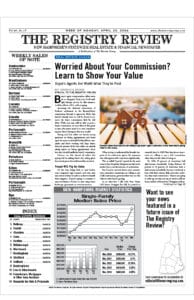
Rising interest rates are changing the residential lending landscape for local banks and credit unions, and encouraging the growth of home-equity lending.
Rising interest rates are changing the residential lending landscape for banks and credit unions across New Hampshire.
Much attention has been heaped on the fact that total home-purchase lending decreased last year by 7 percent in New Hampshire, to $5.71 billion in 2022 from $6.14 billion in 2021, according to data compiled by The Warren Group, publisher of The Registry Review.
The number of purchase-mortgage deals correspondingly plummeted by 16.8 percent, to 15,391 in 2022 from 18,510 in 2021. Similar mortgage trends were seen last year across the nation.
But nonpurchase residential lending – which includes mortgage refinances and home-equity loans and lines of credit – took an even bigger hit last year across the state, falling by 38 percent to $9.13 billion in 2022 from $14.73 billion 2021, according to Warren Group data.
The number of nonpurchase deals plunged by 46.7 percent, to 32,145 transactions in 2022 from 60,418 in 2021.
Interest Rate Pain
Industry figures interviewed for this story attribute the overall declines in purchase and nonpurchase lending primarily to rising mortgage interest rates, which have risen from about 3 percent to nearly 7 percent since the Federal Reserve began aggressively boosting its benchmark short-term interest rate last year to fight inflation.
The net result of the rate spikes: higher costs to buy already expensive homes and much less attractive rates for those seeking mortgage refinancing.
Who were New Hampshire’s top lenders in 2022? Visit our rankings to find out!
“Gone are the days of low interest rates and attractive terms for refinancings,” said Marcus Weeks, president of Meredith Village Savings Bank, the top purchase-mortgage lender statewide last year. “We’re seeing a shift in lending.”
At most banks, the shift is most pronounced in the decline in mortgage refinancings – and the spike in home-equity lending and lines of credit.
Until recently, home-equity loans and lines of credits weren’t popular compared to mortgage-refinance deals, which allowed homeowners to cash-out on home values and/or lower their monthly mortgage payments.
With so many people having refinanced their homes when rates were 4 percent or lower, there’s simply little demand today for refinancings with current mortgage interest rates hovering near 7 percent, officials say.
“Two-thirds of homeowners have rates under 4 percent, so they have no desire to refinance at higher rates,” said Kevin Wells, head of mortgage lending at Mascoma Bank, which is based in Lebanon and which has $2.7 billion in assets.
Hope for HELOCs
But many homeowners still need access to additional money – and home-equity products fit the bill for some, with rates generally hovering in the 7 to 8 percent range.
Wells said his bank has seen a 40 percent increase in home-equity activity over the past few years, requiring his bank to redeploy some of its staff away from its purchase and refinance businesses to home-equity activity, he said.
“We’re seeing this throughout the industry – an increase in home-equity loans,” agreed Mike Mulhern, the assistant vice president in charge of real estate lending at Service Credit Union, which is based in Portsmouth and has about $5.1 billion in assets. “They’re a great instrument for the times.”
Service Credit Union saw more than $200 million in home-equity business last year – up about 40 percent over 2020 activity, said Mulhern.
Other banks and credit unions report similarly large surges in home-equity business at their institutions.
Who are the borrowers taking out home-equity loans and lines of credit – and why?
Some need money to pay for their kids’ college tuitions or for necessary home improvements. Others seek loans to buy cars and other expensive items.
But bankers say a major group of home-equity customers is elder homeowners who, due to the low supply of homes for sale in New Hampshire and elsewhere, have decided stay put for the time being in their current homes.
Some are then taking out loans to refurbish their current homes or condominiums.
But many are taking out home-equity loans to buy smaller houses or condos in cash – and then paying off the home-equity loans once they sell their existing abodes, industry officials say.
“They’re using home-equity loans as a bridge loan to buy another home,” said Service Credit Union’s Mulhern. “A lot of the cash buyers out there are, I suspect, people who have taken out home-equity loans to buy new homes.”
Replacement for Refis?
No one is saying that the surge in home-equity lending will offset the decline in refinancing business.
But the increase in home-equity activity has been a most welcome development.
“The refinance market is virtually dead, but the home-equity market has been huge,” said Robert Cashman, president and CEO of Metro Credit Union, which is based in Chelsea, Massachusetts.
Cashman, whose credit union recently expanded its membership to those living in southern New Hampshire, didn’t provide numbers on much Metro Credit Union’s home-equity business has grown.
But he said there’s been a “significant increase” over the past year.
Most bank and credit-union officials say they expect current lending trends to continue well into 2023 – and as long as rates continue to increase.
“I certainly don’t see refinancing coming back anytime soon,” said MVSB’s Weeks, adding it now seems likely the Fed will continue to hike interest rates over the coming year.

